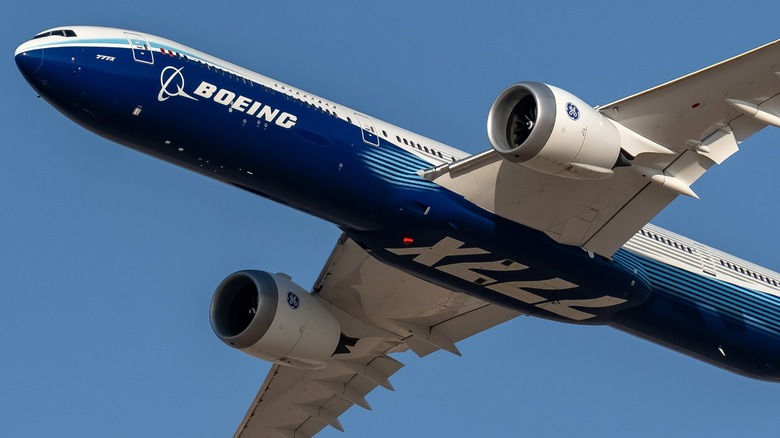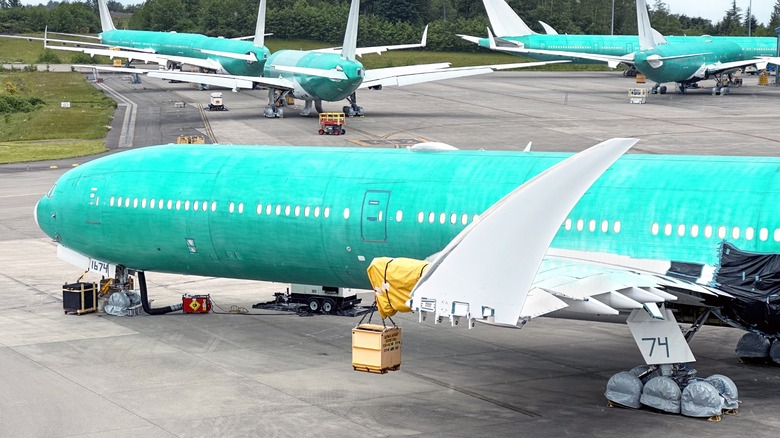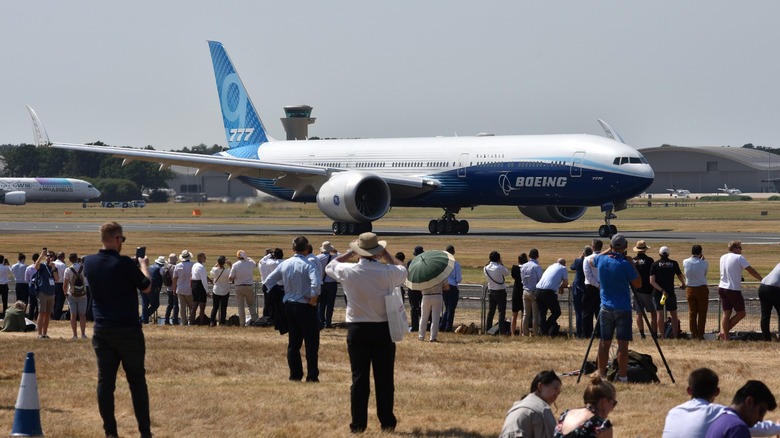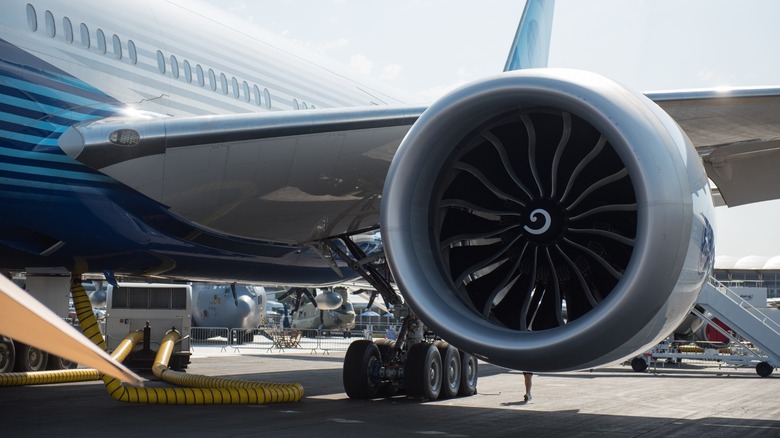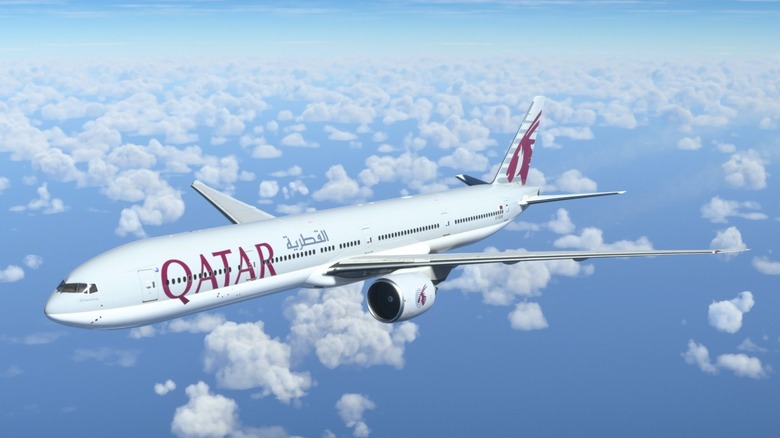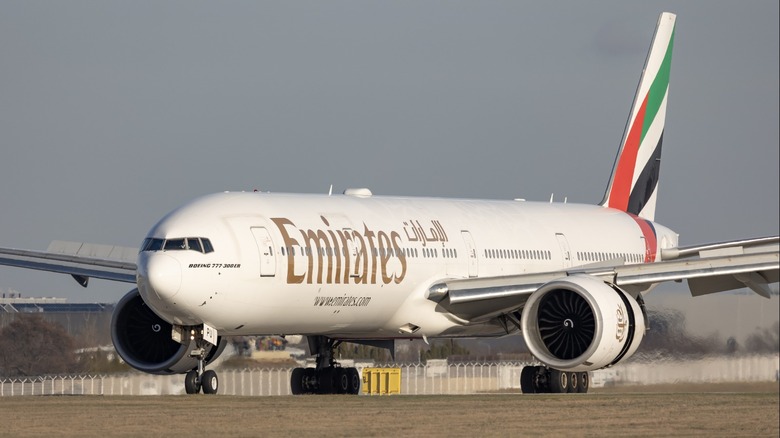Where Is The Boeing 777X And Why Is It Taking So Long To Deliver?
The Boeing 777 is Boeing's longest-range jet currently available in its portfolio, with Boeing 777-200LR having a range of 8,555 nautical miles. This widebody twinjet first flew in 1994 as the Boeing 777-200 and entered service in 1995 with United Airlines. This makes the 777 30 years old in 2024, which makes it quite a dated design.
Nevertheless, Boeing has continued its development, with the introduction of the 777-200ER (extended range) in 1997, the larger 777-300 in 1998, and its extended range variant, the 777-300ER, in 2004. The 777-200LR, Boeing's current long-distance champion, entered service in 2005, while the plane manufacturer also introduced the 777F freighter version in 2009.
Boeing has been working on a new variant of the 777 with the Boeing 777X. This plane was launched in November 2013 — just four years after the entry into service of the 777F. However, it's been more than 10 years since, and we still haven't seen it in commercial service. So, what's happening with the Boeing 777X, and why is it taking so long to deliver?
What is the Boeing 777X?
The 777X is an improvement on the current 777, with its design aiming to give airlines better fuel economy and more seating capacity. The model is supposed to have two major variants, the 777-8 and 777-9, with the former also set to receive a freighter version called the 777-8 Freighter. This plane's headlining feature is its folding wingtips — a world first in commercial aviation. This mechanism will allow the plane to have an ultrawide wingspan of 235 feet and 5 inches (for the 777-8) when deployed. Although this is still shorter than the wingspan of the double-decker Airbus A380, one of the largest planes in the world, with its 261 feet and 8 inches, this is significantly longer than the current 777-200LR/300ER's, which are 212 feet and 7 inches, and the competing A350-900/1000's at 212 feet and 5 inches.
The extended wingtips, plus the extensive use of composite materials and advanced alloys will improve the 777X's flight performance while giving it better fuel efficiency. This will reduce the airline's operating costs, allowing them to lower ticket prices and increase profit margins. However, the extended wingspan means that the 777X would potentially take up more space in airports. This is a problem as it could prevent the plane from using airports and terminals that aren't capable of accommodating it — something that operators of the massive and heavy Airbus A380 know all too well.
Folding wings aren't new technology, as carrier-borne aircraft from as far back as World War II, like the F4F Wildcat and the Mitsubishi A6M Zero, one of the top WWII fighters, already had this then. However, this is the first time that it will be adopted in a commercial airline setting.
When was the Boeing 777X supposed to arrive?
Boeing originally planned to deliver the 777X in 2020 to Emirates, the type's current launch customer. This gives the plane maker seven years to go from the drawing board into customers' hangars. However, the company has hit several snags in its development and production. As of 2024, no airline has received any Boeing 777X yet, meaning the program has already been delayed by four years — but this wasn't always the case. In fact, Boeing was actually on track to hit its planned delivery target as of 2019, when it was completing the assembly of the first 777-9, which was earmarked for Lufthansa.
However, the company started experiencing problems with the plane's engine, which forced it to push back the plane's first flight back by several months, thus affecting the delivery schedule. By August 2020, Boeing is saying that 777X delivery was targeted for 2022 — a two-year delay from its original announcement. 2021 was another year of delay, with the plane manufacturer saying it intended to deliver the aircraft in late 2023.
Then, during its first quarter financial report in April 2022, Boeing further moved back the expected delivery date of the 777X to 2025, making customers wait an additional five years for their new long-haul twinjets from its original plan. This would mean that the plane has been in development, testing, and certification for over 12 years, making it one of the longest aircraft projects in the history of commercial aviation.
Why has the Boeing 777X been delayed multiple times?
As we said earlier, the 777X was actually on schedule until 2019, when the first 777-9 airframe rolled off the factory floor. However, the GE9X engines that were supposed to power the twinjet encountered an anomaly, which necessitated a redesign and further testing. Then, in September of the same year, the 777X suffered a massive blowout during a fuselage pressure test on the ground. Although this was just a test to see the limits of the aircraft, this type of event (a door blowing off during testing) rarely happens. Although it seems that Boeing eventually rectified the issue, it could have caused an added delay to the program, especially as its engineers had to ensure that this would never happen again.
Aside from those two events, we also had the global pandemic of 2020, which shut down production across many factories around the world. There was no news about how this worldwide disaster affected the 777X program, but given how it affected everything, it's safe to say that it had some impact on the Boeing project.
In 2021, the Federal Aviation Administration (FAA) rejected Boeing's request for type inspection authorization, saying that it was dissatisfied with the company's solutions to the myriad of issues that the agency saw with the 777X. As of 2022, the GE9X engines that will power the plane were still having issues, which grounded the test flights for at least two months and pushed deliveries back to 2025.
Which airlines are waiting for the Boeing 777X?
Although the launch delays of the Boeing 777X are understandable in ensuring that it will be a safe aircraft, they would have wreaked havoc on the fleet upgrade plans of the various airlines that ordered the type. German airline Lufthansa was the first to order the 777X, making it the original launch customer of the type. However, it switched some of its firm orders to options in 2019, moving its delivery schedule behind the new launch customer, Emirates. Another Middle East-based airline, Qatar Airways, is also set to become another launch customer for the Boeing 777X — this time, its 777-8F variant.
At the moment, Emirates is the largest 777X customer, with 262 units on order. This is followed by Qatar Airways, which requested 74 units, and Singapore Airlines in third place, with 31 jets in the order book. Aside from these three, the following airlines have also ordered the 777X: Cathay Pacific (21), Lufthansa (27), Etihad (25), ANA (20), British Airways (18), Silk Way West (2), Cargolux (10), Air India (10), and Ethiopian (8).
There are a further 32 orders marked under unidentified customers. This brings the 777X order book to a total of 540 aircraft — all of which have been delayed. Emirates and Lufthansa have already voiced their concerns with the lengthy wait, fearing that Boeing won't be able to make its 2025 promise.
The latest update on the Boeing 777X delivery date
Emirates is expecting deliveries of its 777X orders to start in the second half of 2025, but the airline's CEO also said that this could be delayed again to early 2026 if they were unlucky. The Lufthansa CEO shared the same worry, but ANA and Cathay Pacific said that they weren't expecting any further delays and are looking forward to deliveries next year. However, Boeing found structural damage in one of the 777X test aircraft during scheduled maintenance, with cracks also appearing on two other test airplanes. The damaged part is called a thrust link and holds the engine to the airframe. If this part fails, then the engine could potentially separate from the aircraft while in flight, with disastrous consequences.
Thankfully, it seems that it's easy to replace the part, allowing flight testing to continue with minimal delay. Furthermore, each engine has two thrust links for redundancy. So, even if one fails, there would still be another one keeping the engine in its place under the wing. The thrust link isn't an issue with the GE9X engine, which already had several problems in the past. Instead, Boeing designed the part so that it's different from the thrust links used in older variants of the 777. Nevertheless, the multiple delays the project experienced in the past are likely making Boeing's customers nervous.
Hopefully, Boeing can resolve this issue as quickly as possible, and no other problem appears on the horizon. That way, the Boeing 777X could finally take to the skies in commercial operations, allowing it to enter revenue service after more than a decade of development, testing, and certification.
